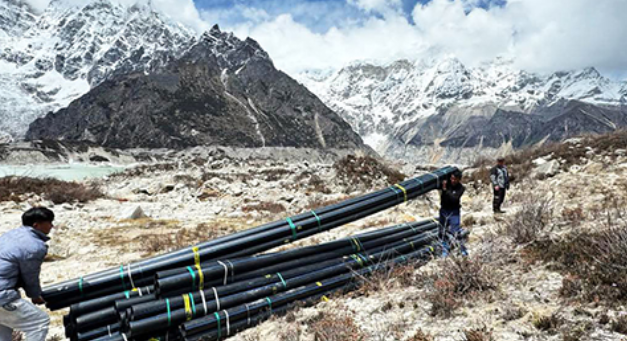Agency: High in the remote valleys of Lunana, Bhutan’s efforts to prevent a glacial disaster are underway in real time. The National Centre for Hydrology and Meteorology (NCHM) has begun the testing phase of a siphoning system at Thorthormi Lake, carefully drawing water into Pho Chhu to reduce the risk of a sudden flood.
Currently, the NCHM technical team is at the site, monitoring every step of the operation. Long, 500 meters HDPE pipes have been laid across the rugged terrain, connecting the lake to the downstream river. Water is being siphoned gradually, with engineers constantly checking flow rates, pipe alignment, and pressure levels to ensure stability.
“This is a delicate process,” said a team engineer. “Even small miscalculations can affect the system, so we are closely observing how the pipes respond under different temperatures and water levels.”
The rapid assessment team faces ongoing challenges. Ice buildup inside the pipes, shifting terrain due to melting ice, and fluctuating water volumes all affect performance. To tackle this, engineers are manually adjusting pipe angles, clearing minor blockages, and testing sections under controlled conditions before opening more water flow.
Early observations are promising. Water is flowing steadily through several pipe sections, and the team is recording data on how much water can be siphoned safely per hour. These readings will help determine whether the method can be scaled up for full implementation. “We are still learning how the system behaves in extreme cold and uneven terrain,” the engineer explained. “This phase is critical for planning future mitigation measures.”
For local communities downstream, the testing phase is a source of cautious hope. Farmers and villagers in Punakha and Wangdue are watching updates closely, aware that the success of the siphoning system could prevent disaster
As the testing phase continues, the NCHM technical team remains on-site, adjusting, taking readings, and learning from every challenge. Each successful drop of water siphoned is a step toward reducing the risk of a glacial flood, a reminder that in Bhutan, preparation, persistence, and technical skill go hand in hand in safeguarding lives and communities.

